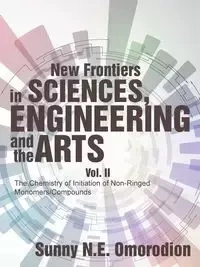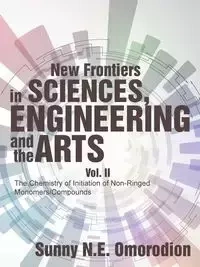New Frontiers in Sciences, Engineering and the Arts - Sunny N.E. Omorodion
- Vol. II The Chemistry of Initiation of Non-Ringed Monomers/Compounds
This book subtitled “The Chemistry of Initiation of Non-Ringed Compounds/Monomers” is the second Volume [Vol. (II)] of the book titled “The New Frontiers in Sciences, Engineering and the Arts”. For a compound to undergo Initiation, it must be such that has what is called Activation center(s) wherein there are three kinds of many types. When such compounds are activated, they can be made to undergo either polymeric or chemical reactions. When made to undergo polymeric reactions, the compounds are said to be Addition monomers. It is only when the Initiation Step is favoured by the monomer using an Initiator, that the Propagation Step begins, just as when a child is born into our world, the child begins to grow. If the Initiation Step is not favoured, due to presence of what are called Transfer Species, then chemical reactions take place to give non-polymeric products under Equilibrium mechanism conditions.
There are different kinds and types of Transfer Species. They are so important to the point where they indeed embrace the first law in Chemistry, that which has been called ‘The law of Conservation of transfer of transfer species”, almost analogous to the Conservation laws in Engineering. Based on this law, so many new concepts too countless to list were identified. How some compounds/monomers rearrange to give other compounds/monomers via different kinds of phenomena all new to Present-day Science, have been identified. So also, are the concepts of Resonance Stabilization which was thought to take place chargedly, something very impossible. There are also many monomers which Present-day Science activate chargedly, things all found to be impossible. Indeed, as has been said, all chemical reactions take place only radically, while only some polymeric reactions take place chargedly, in view of the types of mechanisms involved.
Different families of compounds/monomers with activation centers, both known and unknown, olefinic and non-olefinic were considered, providing their chemical behaviours under different operating conditions, based on the New Science. Unlike what is known in Present-day Science, there are Males (called Electrophiles) and Females (called Nucleophiles) compounds/monomers; indeed, more of Females than Males. While Males carry at least two different types of Activation centers cumulatively or conjugatedly placed, Females carry one, two or more same types of activation centers. How these monomers all coming from different family trees favour the routes favoured by them have been shown, even to the point where some which could not be polymerized by Present-day Science, can now be polymerized.
For the first time, one has shown what the Hydrocarbon family tree looks like. In view of the absence of hetero atoms in the tree, there are no Males for those that carry Activation centers.
For the first time, Azo compounds including hydrocarbons have been renamed and reclassified. How they decompose when catalyzed and non-catalyzed, have begun to be shown. They are important, because from there one began to distinguish between surface and laboratory or industrial chemistry. For the first time, one showed how membranes can be obtained from chitins. So also, one has shown how the oxidation of ortho-xylene which Present-day Science thought was also combustion to give phthalic anhydride using vanadium pentoxide takes place. From all indications, a NEW SCIENCE has emerged.
EAN: 9781546202035




This book subtitled “The Chemistry of Initiation of Non-Ringed Compounds/Monomers” is the second Volume [Vol. (II)] of the book titled “The New Frontiers in Sciences, Engineering and the Arts”. For a compound to undergo Initiation, it must be such that has what is called Activation center(s) wherein there are three kinds of many types. When such compounds are activated, they can be made to undergo either polymeric or chemical reactions. When made to undergo polymeric reactions, the compounds are said to be Addition monomers. It is only when the Initiation Step is favoured by the monomer using an Initiator, that the Propagation Step begins, just as when a child is born into our world, the child begins to grow. If the Initiation Step is not favoured, due to presence of what are called Transfer Species, then chemical reactions take place to give non-polymeric products under Equilibrium mechanism conditions.
There are different kinds and types of Transfer Species. They are so important to the point where they indeed embrace the first law in Chemistry, that which has been called ‘The law of Conservation of transfer of transfer species”, almost analogous to the Conservation laws in Engineering. Based on this law, so many new concepts too countless to list were identified. How some compounds/monomers rearrange to give other compounds/monomers via different kinds of phenomena all new to Present-day Science, have been identified. So also, are the concepts of Resonance Stabilization which was thought to take place chargedly, something very impossible. There are also many monomers which Present-day Science activate chargedly, things all found to be impossible. Indeed, as has been said, all chemical reactions take place only radically, while only some polymeric reactions take place chargedly, in view of the types of mechanisms involved.
Different families of compounds/monomers with activation centers, both known and unknown, olefinic and non-olefinic were considered, providing their chemical behaviours under different operating conditions, based on the New Science. Unlike what is known in Present-day Science, there are Males (called Electrophiles) and Females (called Nucleophiles) compounds/monomers; indeed, more of Females than Males. While Males carry at least two different types of Activation centers cumulatively or conjugatedly placed, Females carry one, two or more same types of activation centers. How these monomers all coming from different family trees favour the routes favoured by them have been shown, even to the point where some which could not be polymerized by Present-day Science, can now be polymerized.
For the first time, one has shown what the Hydrocarbon family tree looks like. In view of the absence of hetero atoms in the tree, there are no Males for those that carry Activation centers.
For the first time, Azo compounds including hydrocarbons have been renamed and reclassified. How they decompose when catalyzed and non-catalyzed, have begun to be shown. They are important, because from there one began to distinguish between surface and laboratory or industrial chemistry. For the first time, one showed how membranes can be obtained from chitins. So also, one has shown how the oxidation of ortho-xylene which Present-day Science thought was also combustion to give phthalic anhydride using vanadium pentoxide takes place. From all indications, a NEW SCIENCE has emerged.
EAN: 9781546202035

